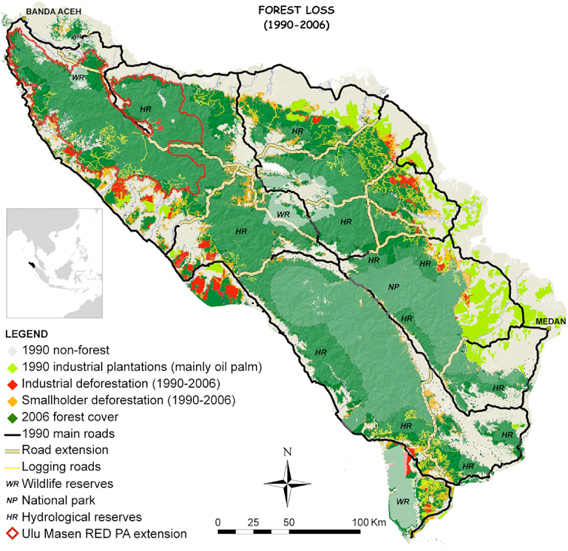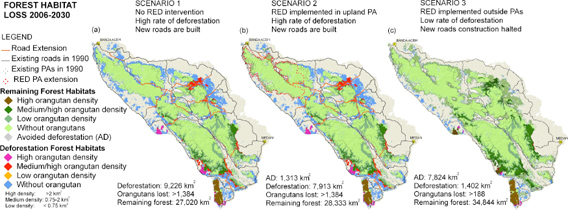A prominent REDD project in Aceh, Indonesia probably won’t be enough to save Northern Sumatra’s endangered lowland rainforests from logging and conversion to oil plantations and agriculture, report researchers writing in Environmental Research Letters.
The study highlights the contradiction between the Ulu Masen conservation project — which involves Flora and Fauna International, Bank of America, and Australia-based Carbon Conservation, a carbon trading company — and the continuing road expansion, and establishment of oil palm plantations in the region.
The project focuses mostly on highland areas that are at lower risk of deforestation due inaccessibility and aren’t particularly good habitat for orangutans, a key conservation priority in Sumatra, note the authors, led by David Gaveau of University of Kent. Meanwhile, an extensive network of roads is currently under construction in the interior of Aceh’s forests, while companies are converting lowland forests into oil palm plantations.

Using a high resolution, spatially explicit deforestation model that forecasts land use change across the region under different scenarios, the researchers find that a payments-for-forest-conservation scheme would be more effective if it is applied at the provincial level across all remaining forest landscapes to include critical lowland forest habitats in the REDD scheme, rather than within a block of mostly upland forest like Ulu Masen and if the construction of new roads was halted.
“Our predictions suggest that Indonesia’s first RED initiative in an upland PA may not significantly reduce deforestation in northern Sumatra and would have little impact on orangutan conservation because a large amount of forest inside the project area is protected de facto by being inaccessible, while lowland forests will remain exposed to the combined expansion of high-revenue plantations and road networks,” they write. “In contrast, RED would be more effective in terms of its conservation impact if payments were extended to all remaining carbon-rich tropical forests, including lowland peat swamp forests, the preferred habitat for dense populations of orangutans, and if the construction of new roads was halted.”

The Ulu Masen REDD project will rely primarily on law enforcement to avoid deforestation within the boundary of the project area. A provincial-level REDD scheme cannot rely on law enforcement because it would include unprotected areas. Instead, it must rely on direct payments to forest users. But as the authors note, a provincial-level REDD scheme will be unlikely to compete with other forms of land use, especially in areas suitable for agricultural and plantations made accessible by new roads, unless compensation for forest carbon is high.
Thus inclusion of below-ground carbon stored in peatlands would help make REDD economically more competitive with other forms of land use and thereby increase the likelihood that Sumatra’s lowlands forests — and their resident biodiversity — can be protected.
Please note: Maps of deforestation in Aceh can be accessed without loss of details in Google Earth format at http://sumatranforest.org/northernSumatra.php
CITATION:
David L A Gaveau, Serge Wich, Justin Epting, Daniel Juhn, Markku Kanninen and Nigel Leader-Williams. The future of forests and orangutans (Pongo abelii) in Sumatra: predicting impacts of oil palm plantations, road construction, and mechanisms for reducing carbon emissions from deforestation [OPEN ACCESS]. Environ. Res. Lett. 4 (July-September 2009) 034013 doi:10.1088/1748-9326/4/3/034013
Related articles